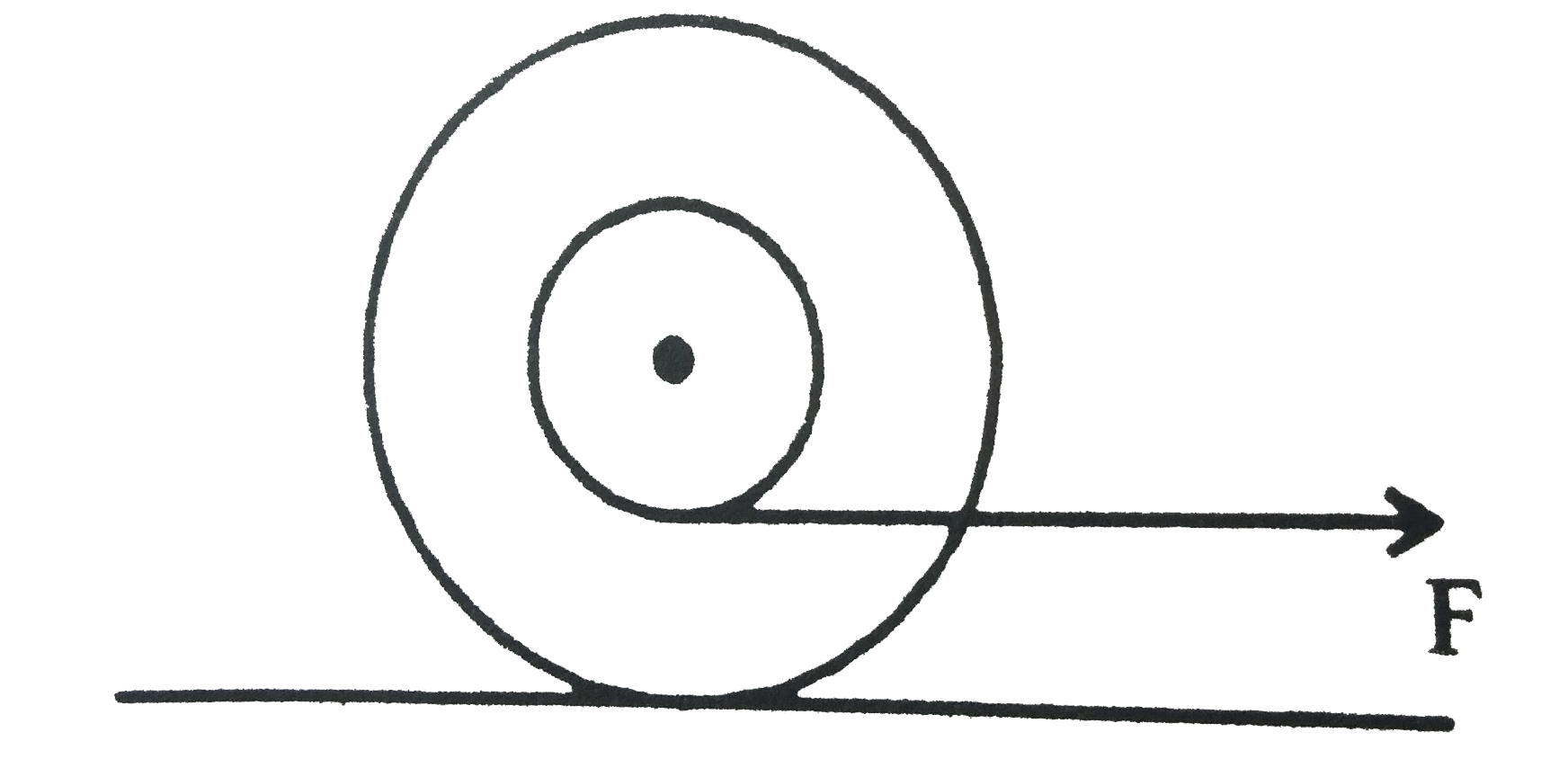Inner and outer radii of a spool are r and R respectively. A thread is wound over its inner surface and placed over a rough horizontal surface. Then:
 .
.
Thread unwinds, spool rotates anticlockwise and friction acts leftwards
Thread winds, spool rotates clockwise and friction acts leftwards
Thread winds, spool moves to the right and friction act rightwards
Thread winds, spool moves to the right and friction does not come into existence
The correct Answer is:B

For pure rolling point of contact must be the rest. (a+Rα=0) For that spool must rotate clock wise.
Similar Questions
Knowledge Check
Inner and outer radii of a spool are r And R respectively. A thread is wound over ita ineer surface and placed over a rough horizontal surface. Thread is pulled by a force F as shown in the figure. Then in case of pure rolling.
 Athread unwinds, spool rotates anticlockwise and friction leftwardsBthread winds, spool rotates clockwise and friction leftwardsCthread winds, spool moves to the right and friction acts rightwardsDthread winds, spool moves to the right and friction does not come into existence
Athread unwinds, spool rotates anticlockwise and friction leftwardsBthread winds, spool rotates clockwise and friction leftwardsCthread winds, spool moves to the right and friction acts rightwardsDthread winds, spool moves to the right and friction does not come into existenceInner and outer radii of a spool are r and RI, respectively. A thread is wound over its inner surface and spool is placed over a rough horizontal surface. Thread is pulled by a force F as shown in Fig. In case of pure rolling, which of the following statements are false?
 AThread unwinds, spool rotates anticlockwise and friction acts leftwards.BThread winds, spool rotates clockwise and friction acts leftwards.CThread winds, spool moves to the right and friction acts rightwards.DThread winds, spool moves to the right and friction does not come into existence.
AThread unwinds, spool rotates anticlockwise and friction acts leftwards.BThread winds, spool rotates clockwise and friction acts leftwards.CThread winds, spool moves to the right and friction acts rightwards.DThread winds, spool moves to the right and friction does not come into existence.A spool of mass m has moment of inertia I=2mR2 about its axis of symmetry. The inner and outer radius of spool R and 2R respectively. Thread is wounded on the inner cylinder and its one end is pulled a force F acting at angle θ with horizontal. The surface is sufficiently rough and th.e spool never slides on the surface.

Maximum frictional force acting on the spool is:AF2 towards rightB2F3C5F6DF6

Inner surfaec of a cylindrical shell of length l and of material of thermal conductivity k is kept at constant temperature T1 and outer surface of the cylinder is kept at constant temperature T2 such that (T1>T2) as shown in figure. heat flows from inner surface to outer surface radially outward. inner and outer radii of the shell are R and 2R resspectively. Due to lack of space this cylinder has to be replaced by a smaller cylinder of length l2 inner and outer radii R4 and R respectively and thermal conductivity of material nk. if rate of radially outward heat flow remains same for same temperatures of inner and outer surface i.e., T1 and T2 then find the value of n.
View SolutionA spool of mass m has moment of inertia I=2mR2 about its axis of symmetry. The inner and outer radius of spool R and 2R respectively. Thread is wounded on the inner cylinder and its one end is pulled a force F acting at angle θ with horizontal. The surface is sufficiently rough and th.e spool never slides on the surface.

For θ=0∘, the acceletation of spool is
View SolutionA spool of mass m has moment of inertia I=2mR2 about its axis of symmetry. The inner and outer radius of spool R and 2R respectively. Thread is wounded on the inner cylinder and its one end is pulled a force F acting at angle θ with horizontal. The surface is sufficiently rough and th.e spool never slides on the surface.

For θ=60∘ the acceleration of spool is
View SolutionA spool of mass m has moment of inertia I=2mR2 about its axis of symmetry. The inner and outer radius of spool R and 2R respectively. Thread is wounded on the inner cylinder and its one end is pulled a force F acting at angle θ with horizontal. The surface is sufficiently rough and th.e spool never slides on the surface.

Regarding to the direction of rotation of spool which of the following statement is true?
View SolutionA spool of mass m has moment of inertia I=2mR2 about its axis of symmetry. The inner and outer radius of spool R and 2R respectively. Thread is wounded on the inner cylinder and its one end is pulled a force F acting at angle θ with horizontal. The surface is sufficiently rough and th.e spool never slides on the surface.

Regarding to the direction of frictional force, which of the following statement is correct?
View Solution
